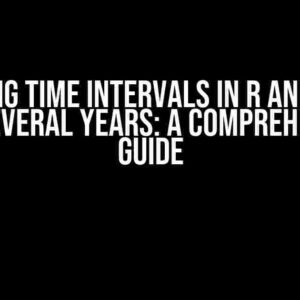Are you tired of switching between R and Python for your data analysis needs? Do you want to leverage the power of R’s statistical capabilities while still being able to define matrices like a pro in Numpy? Look no further! In this comprehensive guide, we’ll show you how to define a matrix in R in a similar fashion as with Numpy.
In R, a matrix is a two-dimensional array of numbers, symbols, or expressions. It’s a fundamental data structure in R, used to store and manipulate data in a compact and efficient manner. Matrices are essential in various fields, including statistics, linear algebra, machine learning, and data analysis.
There are several reasons why you’d want to define a matrix in R:
- Efficient Data Storage: Matrices allow you to store large datasets in a compact form, making it easier to manipulate and analyze your data.
- Vectorized Operations: R’s matrix operations are vectorized, meaning you can perform operations on entire matrices at once, making your code more concise and efficient.
- Statistical Analysis: R is renowned for its statistical capabilities, and matrices are a fundamental data structure for many statistical techniques, such as regression analysis and hypothesis testing.
- Interoperability: Matrices are a common data structure across many programming languages, including Python, making it easy to share data and results with colleagues and collaborators.
To create a matrix in R, you can use the matrix() function, which takes three arguments:
data: The vector of values to fill the matrix.nrow: The number of rows in the matrix.ncol: The number of columns in the matrix.
# Create a 3x4 matrix with values 1-12 m <- matrix(1:12, nrow = 3, ncol = 4) print(m)
| 1 | 4 | 7 | 10 |
| 2 | 5 | 8 | 11 |
| 3 | 6 | 9 | 12 |
R provides a wide range of matrix operations, including:
- Matrix Addition: Add two matrices element-wise using the
+operator. - Matrix Subtraction: Subtract two matrices element-wise using the
-operator. - Matrix Multiplication: Multiply two matrices using the
%*%operator. - Matrix Transpose: Transpose a matrix using the
t()function. - Matrix Inverse: Calculate the inverse of a matrix using the
solve()function.
# Matrix addition m1 <- matrix(1:4, nrow = 2) m2 <- matrix(5:8, nrow = 2) m_sum <- m1 + m2 print(m_sum)
| 6 | 8 |
| 10 | 12 |
If you're familiar with Numpy, you might be wondering how to define a matrix in R using a similar syntax. The good news is that R's matrix() function is similar to Numpy's numpy.array() function.
# Numpy syntax import numpy as np m_np = np.array([[1, 2, 3], [4, 5, 6], [7, 8, 9]]) print(m_np)
# R syntax m_r <- matrix(c(1, 2, 3, 4, 5, 6, 7, 8, 9), nrow = 3, ncol = 3, byrow = TRUE) print(m_r)
| 1 | 2 | 3 |
| 4 | 5 | 6 |
| 7 | 8 | 9 |
As you can see, the byrow = TRUE argument in R's matrix() function allows you to specify the matrix elements row-by-row, similar to Numpy's syntax.
In this article, we've shown you how to define a matrix in R in a similar fashion as with Numpy. By understanding the basics of matrix creation and operations in R, you can unlock the full potential of R's statistical capabilities and integrate your R workflows with Python and other programming languages.
Remember, matrices are a fundamental data structure in R, and mastering their creation and manipulation is essential for any data analyst or scientist.
So, what are you waiting for? Start defining your matrices in R today and take your data analysis to the next level!
Frequently Asked Question
Get ready to dive into the world of R matrices, where data manipulation meets flexibility!
How do I define a matrix in R similar to Numpy?
In R, you can define a matrix using the `matrix()` function, similar to Numpy. The basic syntax is `matrix(data, nrow, ncol)`, where `data` is the vector of values, `nrow` is the number of rows, and `ncol` is the number of columns. For example: `matrix(c(1, 2, 3, 4, 5, 6), nrow = 2, ncol = 3)` creates a 2x3 matrix.
Can I use a vector to create a matrix in R?
Yes, you can use a vector to create a matrix in R. The `matrix()` function can take a vector as an argument, and it will automatically fill the matrix column-wise. For example: `matrix(1:6, nrow = 2)` creates a 2x3 matrix filled with the values 1 to 6.
How do I specify the dimension names of a matrix in R?
You can specify the dimension names of a matrix in R using the `dimnames` argument. For example: `matrix(c(1, 2, 3, 4, 5, 6), nrow = 2, dimnames = list(c("row1", "row2"), c("col1", "col2", "col3")))` creates a matrix with custom row and column names.
Can I convert a data frame to a matrix in R?
Yes, you can convert a data frame to a matrix in R using the `as.matrix()` function. Note that this will only work if the data frame contains only numeric or logical columns. For example: `df <- data.frame(x = 1:3, y = 4:6); as.matrix(df)` converts the data frame `df` to a matrix.
Are matrix operations in R similar to Numpy?
Yes, matrix operations in R are similar to Numpy. Both R and Numpy support common matrix operations like matrix multiplication, matrix addition, and element-wise operations. However, R also provides additional functionality for statistical analysis and data manipulation.

